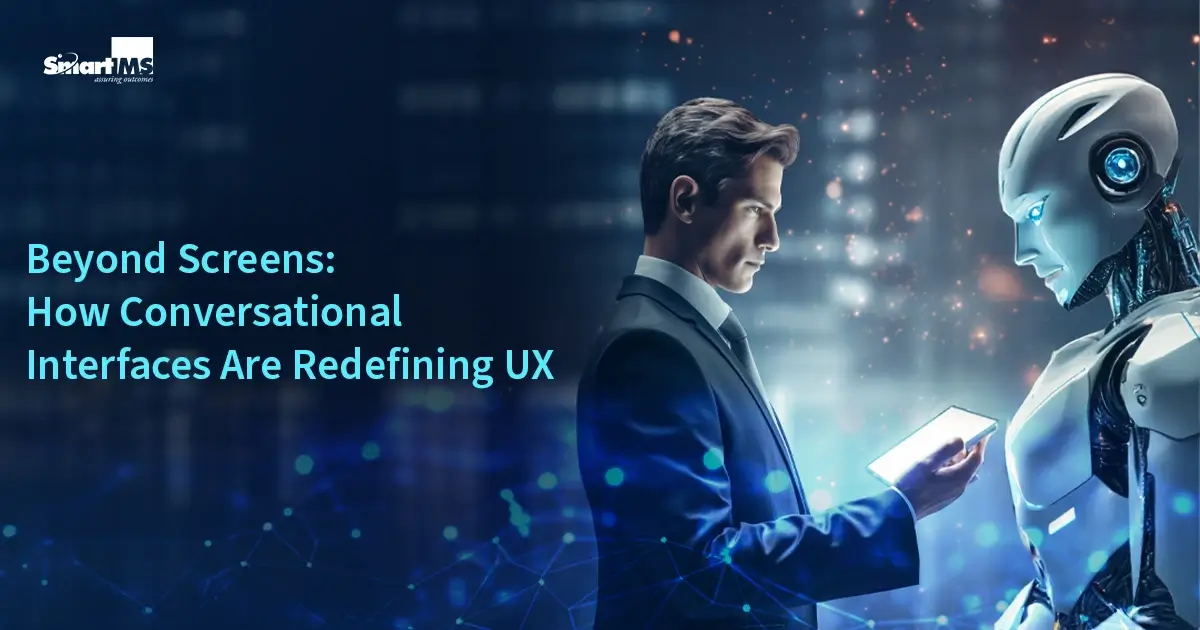For years, UX design has been rooted in screens.
We’ve built experiences around menus, cards, forms, and buttons.
We’ve obsessed over navigation patterns, transition states, and click flows.
The interface was the product, and it had to be perfect.
But artificial intelligence is shifting that foundation.
We’re now entering an era where UX is no longer something users must click through.
It’s something they can talk to.
Or Message.
Or hint at—without even opening an app.
This is the age of conversational UX, where language becomes the interface and design becomes about understanding, not navigation. This shift is not just cosmetic. It’s structural. And it’s here to stay.
From Flows to Fulfillment
The way we interact with digital systems is being fundamentally reimagined.
What once took a series of clicks, taps, and forms now takes a sentence.
Let’s break it down.
You used to:
→ Open a food delivery app
→ Browse categories
→ Pick “Thai”
→ Scroll through 20 options
→ Customize your order
Now you just say:
“Order my usual green curry for lunch.”
Or take scheduling:
You used to:
→ Open your calendar
→ Pick a time
→ Draft an invite
→ Add guests
→ Confirm availability
Now it’s simply:
“Schedule a 30-minute sync with my product team for tomorrow afternoon.”
What was once a journey across a screen has become a straight line from intent to fulfillment.
This new interaction model drastically reduces friction—and that is where the power of conversational UX lies.
Why It’s a Shift, Not a Feature?
The transition we’re seeing isn’t about layering chatbots onto existing platforms or upgrading voice UIs.
It’s about rethinking how systems interpret human language and deliver outcomes, without needing users to first understand how the system works.
In traditional UX, the user has to learn the tools.
In conversational UX, the system learns the user.
Old UX:
“Here are the tools. Figure out how to get what you want.”
New UX:
“Tell me what you want. I’ll handle the rest.”
This shift transforms experiences.
When done right, conversational UX makes interactions seamless, intuitive, and human-like. It reduces steps, increases clarity, and builds trust—not through visuals, but through intelligence.
To design for this shift, the very nature of UX design must evolve.
Designing for Conversations, Not Screens
As interfaces move away from buttons and pages, the work of a designer is no longer about arranging layouts.
It’s about interpreting human intention and guiding systems to act on it accurately and safely.
That means focusing on:
• Understanding how users express goals
• Structuring prompts and intent patterns
• Architecting how AI models interpret, respond, and take action
• Building safety, clarity, and fallback strategies without visual cues
The designer’s canvas is no longer the screen—it is language, context, and cognition.
They design how AI collaborates with humans.
They design understanding.
They create invisible affordances that respond to tone, phrasing, even hesitation.
This evolution becomes even more vital in industries like insurance, where complexity often deters clarity.
The Impact on P&C Insurance
Few industries stand to gain as much from conversational UX as property and casualty insurance.
Long reliant on legacy systems, complex workflows, and manual service processes, insurance is overdue for an experience transformation.
Here’s how conversational UX is already redefining engagement for both customers and professionals in the space.
For Policyholders
Traditionally, if a policyholder wanted help, the process looked like this:
→ Log in to a portal
→ Look up policy documents
→ Try to interpret coverage clauses
→ Fill out a multi-page claim form
→ Wait for an email or callback
This wasn’t just tedious. It was confusing, slow, and impersonal.
Now imagine instead:
“Start a claim for water damage in my kitchen from this morning.”
or
“Is my engagement ring covered if I travel abroad?”
The system can immediately interpret the query, cross-reference coverage, verify deductibles, initiate FNOL, and respond within seconds.
There’s no paperwork. No phone tag. No ambiguity.
Just clear, immediate assistance through natural conversation.
For Agents and Brokers
Professionals on the other side of the equation face their own set of challenges:
• Navigating complex quoting tools
• Sifting through product PDFs
• Reaching out to underwriters for exceptions
• Drafting emails, follow-ups, and reports
With conversational interfaces, these steps can be simplified dramatically.
An agent can now ask:
“Quote a $1M general liability policy for a bakery in Pennsylvania.”
or
“Which clients have upcoming renewals with cross-sell potential?”
The system pulls from policy databases, runs underwriting rules, identifies opportunities, and assembles everything the agent needs—instantly.
This not only saves time, it allows agents and brokers to focus on what matters most: relationships and strategy, not admin work.
Enter Xymphony: NLX for Insurance, Done Right
This is exactly where Xymphony comes in.
Built on a powerful agentic AI foundation, Xymphony offers a unified experience layer across your P&C insurance ecosystem. It enables policyholders, agents, and brokers to engage with your systems naturally—across voice, chat, or embedded UIs.
- Natural Language Experience (NLX) across all channels
- Plug-and-play integration with your existing core systems
- AI-driven co-pilots for agents and service teams
- Secure and compliant orchestration of quoting, servicing, and claims
With Xymphony, you don’t need to rip and replace.
You simply add a layer of intelligence and language—and transform the experience across the board.
Final Thoughts!
The future of UX won’t be something we look at.
It will be something we speak to.
Message.
Or even just imply.
The best user experiences will not rely on visual brilliance.
They will be felt—through speed, ease, and accuracy.
If you’re building digital experiences for insurance, this is the shift to watch.
The winners won’t be those with the best portals.
They’ll be the ones who listen best—and respond fastest.
Welcome to the era of conversational insurance.
Let’s talk. Contact Us Today!
References:
AI’s Invisible UI: Designing for Intent, Not Interfaces | by Shanah | Muzli – Design Inspiration
Invisible UX is coming – Felix Haas (LinkedIn Post)
NLX is the new UX – Microsoft CPO: If you aren’t prototyping with AI, you’re doing it wrong | Aparna Chennapragada



